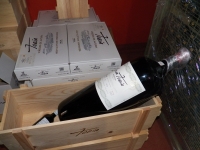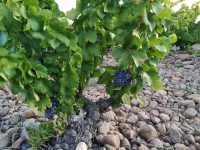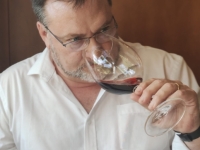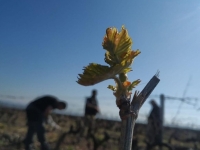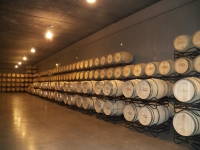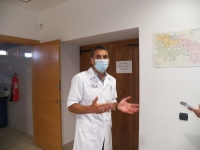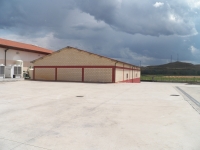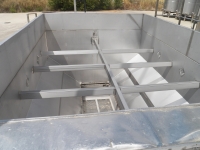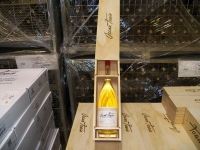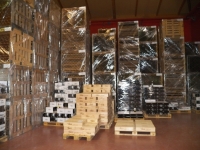Travel
From the vineyard to the glass, the long journey of wine
We accompany Bodegas Tobia, in La Rioja
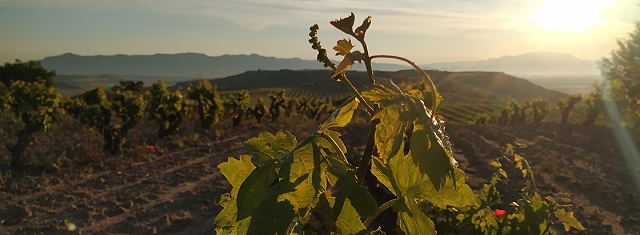
Spring in the vineyards (Source: Rosana Rivera)
USPA NEWS -
Experts say that there are no good and bad wines, that everything depends on the taste of those who drink them. Certainly, the quality of a wine is related to multiple factors, sometimes intangible, that overlap during the production process. A process that requires, above all, patience. Because when a wine leaves the cellar onto the store shelves, it leaves behind months and months of hard work that begins at least a year before, when the previous harvest ends.
In La Rioja, the most important wine region in Spain and one of the most important in the world, the mornings are cool at the end of August. It is the moment when the harvest starts, first in the easternmost areas of the region and then moving westward in the rest of the territory. On the western edge of the province, one winery stands out from the rest. His wines have received countless awards and numerous recognitions - the latest, the more than 90 points obtained by various of his wines, awarded by Wine Spectator magazine - in international forums. Located in Cuzcurrita del Río Tirón, although originally from nearby San Asensio, Bodegas Tobía boasts good grapes and quality wines.
Inland Spanish region, in the north of the Iberian Peninsula, La Rioja occupies a privileged area, protected to the north by high mountains that regulate the flow of rain and wind. The Ebro river - the largest in the country - crosses it from west to east and, through its valley, La Rioja receives the influence of the Mediterranean sea. And that shows on the ground. "The secret of a great Rioja wine is in the blend." In the mixture of grapes and vineyards, but also in the soil. And in this area of Rioja it is particularly rich in nutrients such as limestone, explains to USPA News Diego Orío, winemaker right-hand man of the master winemaker and architect, Óscar Tobía.
The calcareous clay soil is best for the Tempranillo grape variety, traditionally the base of many Rioja wines. However, in recent years a decrease in the acidity of Tempranillo grapes has been detected, related to the climatic conditions of each campaign. "We have to correct it in the winery and you can see that later in the wine," says Diego Orío. For this reason we are selecting vineyards at altitude, which better preserve the acidity of the grape. Tobía's are wines of great freshness, pleasant to the palate, rich in nuances. Along with Tempranillo, now "the garnacha is in fashion, more fruity and with softer tannin, and also graciano and red maturana, which is native to Rioja and with it, fresher, highly colored wines with more spicy aromas are obtained," he explains Diego Orío. Among the four varieties and some others that are gaining presence in this region, the white varieties of Tempranillo Blanco, Maturana Blanca and Chardonnay, form the core of the new Rioja wines. The combinations are almost endless, not in vain La Rioja "is the land of a thousand wines", recalls the winemaker.
The increase in temperature "promotes the vegetative development of the vine and the growth of the clusters, which at the end of July and the beginning of August begin the veraison, stage in which the grapes take their final color," explains to USPA News Alina Castro, head of Wine Tourism and Public Relations at Bodegas Tobía. "This is the beginning of the real ripening process, during which the levels of sugar, malic and tartaric acid, aromatic precursors and anthocyanins will gradually evolve", she adds during a Winetour at the foot of the vineyard.
Summer is the period when the vines are most at risk of contracting diseases such as powdery mildew and mildew, or pests such as cluster moths, spider mites and others. Powdery mildew was the first disease of American origin that had a lethal impact on European vineyards, including those of La Rioja, where it appeared between 1850 and 1860. “Popularly known as 'ash' due to its appearance of gray-whitish powder, powdery mildew thrives in warm and humid conditions, affecting the herbaceous parts of the vine,“ explains Alina Castro.
For its part, downy mildew appeared for the first time in La Rioja in 1885. It is a fungus that, after sprouting, attacks leaves, buds, flowers and racemes when there are conditions of high humidity and temperatures that exceed 12º-15ºC.
The harvest, end and beginning
Each wine is born at the end of the previous vintage. At Bodegas Tobía, the harvest involves 25 different municipalities, as they select high-quality vineyards spread throughout the entire geography of Rioja. The harvest period lasts between 1.5 and two months and develops in a staggered manner. When it is finished, the vines enter a period of rest that will last until next spring. At first, the vines change their color from green to reddish gold. In winter, the pruning will come. Let the plant rest and remove the branches that may prevent the vigorous growth of new shoots. In La Rioja Alta, to the west of the region, where Bodegas Tobía is located, the winters are cold and the snow is a regular visitor to the fields.
"Wine is born in the vineyard, but it is made in the winery," emphasizes Diego Orío. While the vineyards rest in the field after an intense campaign, work is carried out inside the winery that will lead to the wines that will later be tasted in houses, restaurants and wine competitions, and that begin in the offices and the laboratory: there are to plan the harvest. The moment of harvesting the grapes depends on its degree of ripeness and the ripening depends on the climatic conditions. Mild winters and dry summers give the wines a different degree of alcohol and acidity than those generated by cold winters and hot summers. Work in the winery acquires great importance because wine is, above all, a work of agricultural art, a creation of winemakers who give each wine its own personality.
In a region like La Rioja, with 15,080 winegrowers and more than 500 wineries - one eighth of the total in Spain - commercially active, according to figures from the Regulatory Council of the Qualified Designation of Origin (DOCa its Spanish acronym), the body that ensures the quality of Rioja wines, the number of wines is almost infinite. And each one is different from the others, an achievement that is due to the wineries. The type of harvest, the weather, the quality of the soil, the time of maceration and fermentation, and the mixtures of different types of grapes define each wine. It is an almost alchemical work that takes place in the laboratories of the wineries. "The wines are different, with very small differences," says Diego Orío. Here they test the “contemplative enology“ model: they select a large vineyard and little intervention is made in the winery, since they use the Ganimede method, an intelligent deposit that marks the curious and avant-garde profile of Óscar Tobía, being Bodegas Tobía one of the first wineries in Spain and one of the first in Europe to use this type of winemaking.
“These R&D tanks read (through sensors) physical data, such as: temperature, density, color intensity and redox potential. With the Ganimede method, we make wines in a way that is respectful with the environment, taking advantage of the CO2 released by alcoholic fermentation, pumping is produced in a natural way, where the skins and must ferment being in contact, without the need to pump over them in a natural way. manual, reaching higher homogeneity indices than the traditional method. The extraction of aromas and color is much better,“ explains Alina Castro during the guided tour. They also vinify less bitter and less drying wines. 50% of the quality of a wine "is the result of maceration and fermentation that is conditioned by the vineyard of origin of the grape," adds Diego Orío. Sometimes that percentage goes up to 70%.
The agricultural campaign in the vineyards ends with the harvest. The grapes are taken to the winery, where they are weighed and the DOCa Regulatory Council controls their quality and probable degree of alcohol. If everything is correct, they are discharged into hoppers and from there they are transported to the tanks. Today, most are made of stainless steel. There, the grapes begin their transformation process into wine. There are important differences between young wines, Crianza and Reserva. We might think that these differences come only from the fermentation time in the barrel, but it is more complex. The ripening time of the grapes and their quality are at the origin of the differences between young, Crianza and Reserva.
Young wines are made with grapes from young vines, with higher grape yields per vineyard, and provide less tannins - phenolic compounds that accumulate in fruits and in the bark of plants and trees, which have a very characteristic smell and give the wine a bitter and dry taste - to make the wine smoother and more fruity. On the contrary, Crianza, Reserva and Grandes Reservas wines are usually made with grapes from old vines, with lower grape yields per vineyard that offer a higher concentration and phenolic load and that will allow them to age in oak barrels for a few years unbeatable.
The fermentation of young wines is usually short and at a low temperature. In this way, the fruity aromas of the wine are improved, which is smooth and aromatic. In the case of Crianza, Reserva and Grandes Reservas, the fermentations are long and at a slightly higher temperature, so that the greatest number of tannins and other compounds that provide structure and a certain astringency to the wines are extracted. The aging ones spend at least twelve months in the barrel and another twelve months in the bottle, unlike the Reservas, which spend three years between the barrel and the bottle, while the Grandes Reservas spend five years between the barrel and the bottle. In the case of Bodegas Tobía, all its wines, including the “young“ ones, spend time in oak barrels, with the aim that they be aged wines for good aging.
A family history
Bodegas Tobía is Óscar Tobía's life project. A project that materialized in 1994 in San Asensio, born of his passion for wine from the cradle and having grown up in the cellar of his grandparents winegrowers growers of San Asensio, town of La Rioja Alta. “My grandparents made wine for family consumption in 1942 in the Las Cuevas neighborhood,“ recalls Óscar Tobía. "They were never sold, but I keep fond memories of the harvests, the treading of grapes from a very young age, and that bread dipped in wine that my grandfather Antonio prepared for me." La bodeguita de cosecheros, currently a museum winery that receives winelovers from all over the world, remains intact, as well as the house of the paternal grandparents. It is an old building, from the 18th century.
Óscar Tobía, following the tradition and legacy of his grandparents' grape growers, created the 'Tobía' brand with a vocation for exporting and universal wines. He was trained as an Agronomist Engineer, later Master in Viticulture and Enology. He then began his business adventure in San Asensio, taking a great leap in innovation and creativity in Spain, making the first barrel-fermented rosé in Spain in 1996, 'Alma Tobía' Rosado, his most avant-garde wine. “They were 25 years of hard work and continuous learning to create and publicize the three reference brands of Bodegas Tobía: 'Óscar Tobía', 'Alma Tobía' and 'Tobía'. Signature wines, which are on their way to become a benchmark for the great Rioja wines, witnesses of unforgettable moments and which I hope will illuminate, like me, the path to happiness,“ explains Oscar Tobía. His wines are known outside of Spain because up to 80% of his production has been exported to foreign markets. In 2002, the La Rioja Chamber of Commerce awarded him the Internationalization award. In 2010, due to the growth in production and the practice of wine tourism, they decided to move the winery to a building with better facilities in Cuzcurrita.
From that adventure that still survives, there are more than a hundred awards in competitions and recognitions of the most prestigious publications on wines, such as the Gold Medal in the exclusive Le Mondial Du Rosé competition, in Cannes, for his 'Tobía Luz de Luna' Rosado wine, the last year; the 96 points awarded to the 'Óscar Tobía' Blanco Reserva 2016 and the 95 points to the 'Tobía' Selección de Autor Tinto 2017, in a blind tasting of more than 3,700 wines organized by the Gourmet Wine Guide 2021. Or the 92 points awarded by the North American Wine Spectator to the 'Tobía Selección de Autor' Tinto 2017 wine, the 91 points to the 'Óscar Tobía' Blanco Reserva 2016 or the 90 points to the 'Tobía' Blanco Selección de Autor Blanco 2018. “Bodegas Tobía, from the beginning, has paid much attention to the evolution of the white wines, betting on an update of classic Rioja wines,“ concludes Óscar Tobía, CEO and Cellar Master of Bodegas Tobía.
A deserved recognition of the work of a great winery in La Rioja that, on October 15, ended the 2020 harvest. The grapes harvested then are now sleeping in the barrels of Bodegas Tobía, converted into must, fermenting in wood, acquiring aromas and flavors that wine lovers will enjoy in a few months or a few years. The nectar of the gods, as the classics used to say. The spirit of the Tobía family is found in every bottle that leaves the cellar, wines with soul that radiate light to the most demanding palates.
Liability for this article lies with the author, who also holds the copyright. Editorial content from USPA may be quoted on other websites as long as the quote comprises no more than 5% of the entire text, is marked as such and the source is named (via hyperlink).

